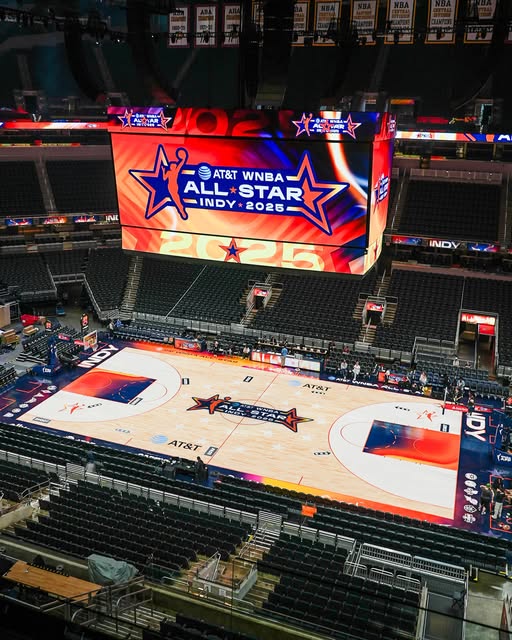In a dazzling revelation that has electrified the world of professional sports and ignited praise from fans, players, and designers alike, the WNBA has just unveiled its breathtaking 2025 All-Star Weekend court. This isn’t just a basketball surface—it’s a vibrant tapestry of empowerment, culture, innovation, and artistic expression woven into every inch of hardwood. With this audacious and purposeful design, the WNBA has not only broken boundaries; it has created a visual and cultural landmark that challenges long-standing norms about how sports venues can reflect society, identity, and future possibilities.
The 2025 WNBA All-Star Weekend, slated to be held in Chicago, has already been the subject of immense buzz due to its lineup of events, star-studded rosters, and community-focused initiatives. But it’s the unveiling of the court—a majestic blend of art, activism, and celebration—that has taken center stage. What sets this design apart isn’t simply its visual appeal, though it is stunning; it’s the rich narrative and intentional storytelling behind every brushstroke, color scheme, and spatial element.
The court is a result of a bold collaboration between the WNBA and a coalition of female architects, street artists, Black and Indigenous creators, and tech innovators. This diverse and dynamic team brought to the table perspectives that are often marginalized in mainstream design processes. As a result, the court tells a story far beyond basketball—a story of women’s collective power, of shared histories, and of an uncompromising future.
At first glance, the court’s aesthetic seizes your attention. Lush purples, golds, and midnight blues pulse across the floor like a living galaxy. A radiant sunburst design anchors center court, symbolizing not only the power and light women bring into the world but also a tribute to Chicago’s iconic public art and skyline. Unlike traditional courts that favor symmetry and uniform coloring, this one embraces asymmetry and gradient transitions. The hardwood visually flows like a river, evoking themes of resilience and movement.
Etched along the sidelines are quotes from legendary women athletes and trailblazers—Maya Angelou, Serena Williams, Tamika Catchings, Billie Jean King—engraved in a stylized cursive that makes the court feel sacred, almost like a page from a living history book. Every quote was chosen through a community voting initiative that encouraged WNBA fans to submit entries and vote on final selections. The result is a deeply democratic court that literally contains the voices of the community it represents.
Another extraordinary feature is the embedded LED-activated graphics that come alive during player introductions, halftime shows, and highlight plays. These lights illuminate patterns that resemble ancestral beadwork, Afrofuturist motifs, and constellations. The technology was developed in partnership with a female-led tech startup that specializes in immersive sports experiences. This innovative approach transforms the court into a living, reactive canvas that shifts with the energy of the game, echoing the dynamism of the athletes who play on it.
But the court’s impact isn’t limited to its appearance or digital wizardry. It’s also a bold declaration of cultural equity and environmental responsibility. The materials used to build the court were sourced sustainably, using bamboo composites and recycled marine plastics. These choices reflect the WNBA’s broader commitment to climate justice and its recognition that environmental degradation disproportionately affects women—particularly women of color—in vulnerable communities. By integrating sustainable practices into something as visible as the All-Star court, the league sends a powerful message that sports and environmental advocacy are not mutually exclusive.
Perhaps most impressively, the court design also incorporates elements of accessibility and inclusion that set a new gold standard in professional sports. The contrast levels between court lines and background colors were chosen to assist visually impaired individuals. Specific audio feedback systems have been embedded under the court to provide cues for players and fans with hearing loss. Seating for the All-Star game will also reflect new inclusive designs, with options tailored for neurodiverse individuals, including calming zones, sensory-friendly lounges, and quiet viewing booths.
The process of creating this masterpiece was itself a masterclass in collaborative leadership. The WNBA intentionally selected design leads who reflect the diversity of its fan base and player community. Among them was Dr. Imani Reyes, an Afro-Latina urban designer known for her work in reclaiming public space for marginalized communities. Reyes emphasized during a press release that the court was “not just built, but curated—with each section intended to honor a dimension of womanhood: strength, creativity, memory, resistance, and joy.”
Also integral to the team was Chief Design Architect Aiko Nakamura, whose visionary contributions blended traditional Japanese art forms with ultramodern aesthetics. Her influence can be seen in the brushstroke patterns that snake across the court, symbolizing perseverance (gaman) and the interconnectedness of women across the globe. These cross-cultural elements aren’t decorative; they serve as visual metaphors that expand the court’s resonance beyond borders and time zones.
The reaction from WNBA players has been overwhelmingly positive. Reigning MVP A’ja Wilson described the court as “a canvas of our story. When I stepped on it, I felt like I was walking into the pages of a book that finally includes us.” Skylar Diggins-Smith echoed that sentiment, saying, “This isn’t just where we play. This is where we belong. Every young girl watching will see that her identity, her heritage, her boldness, all have a place in this league.”
In fact, youth engagement was a central goal of the court’s creation. Through partnerships with schools in the Chicago area, the WNBA invited young girls to participate in focus groups and even contribute to early design concepts. A special mosaic mural, created by students from local girls’ academies, now decorates the tunnel that leads players from the locker rooms to the court. This direct engagement with youth not only fosters a sense of ownership and pride, but it also serves as a mentorship model in which sports become a gateway to careers in art, design, tech, and leadership.
Broadcast partners have also adapted their coverage to highlight the court’s features. Camera angles have been recalibrated to capture the court’s full visual depth, and announcers are being trained on the history and symbolism embedded in the design so they can educate viewers during live telecasts. This intentional storytelling elevates the viewer experience and broadens the educational dimension of watching a WNBA game.
Critically, the media rollout of the All-Star court also embraced a digital-first strategy aimed at virality and cultural relevance. The WNBA partnered with influencers in the sports, design, and social justice spaces to unveil the court via cinematic video teasers. These videos didn’t just showcase the court—they told the story behind it. The unveiling campaign was appropriately titled “More Than a Court,” and it quickly trended on platforms like X, Instagram, and TikTok.
What this court represents, beyond its physical manifestation, is a redefinition of what “professional” looks like in sports. For decades, women’s leagues have been measured against male standards in ways that undervalued innovation, design, and identity. This court flips that narrative. It doesn’t seek validation from tradition—it creates a new tradition. A tradition where design reflects community, where excellence includes empathy, and where the court itself becomes a megaphone for stories that have long gone untold.
The 2025 WNBA All-Star Weekend court is not just a location for athletic competition. It’s an educational tool, a work of public art, a cultural archive, and a technological frontier. It is the physical manifestation of everything the WNBA has worked toward: equity, representation, visibility, and excellence. In doing so, the league has raised the bar—not just for women’s sports, but for all of professional athletics.
While other leagues may have more resources or media coverage, the WNBA has proven that intentionality, inclusion, and creativity can accomplish something far more powerful. The court reminds us that design matters—not just for aesthetics but for meaning. It matters who gets to design, whose stories are told, and what values are literally built into the foundation of our most revered institutions.
This court is already being studied in university design programs and sports management classes across the country. Professors are calling it a “case study in values-driven design,” and students are writing dissertations on its layered symbolism and participatory development process. City planners and sports franchise owners are reaching out to the WNBA to learn how they might replicate aspects of this visionary approach in their own facilities. It is, by all accounts, a movement in motion.
There’s little doubt that the 2025 WNBA All-Star Weekend court will be remembered as a turning point—not just for a league, but for an entire cultural ecosystem. For too long, women’s sports have had to fight for visibility. This court doesn’t just shine a light on women’s excellence—it is the light. It’s a radiant, unapologetic affirmation that women’s stories belong at the center of our collective imagination.
As fans flock to Chicago to witness the All-Star game, they will not simply be watching athletes perform. They will be stepping into a living, breathing statement of what the future of sports can and should look like. A future where every line painted on the hardwood is also a line in a poem about resilience. A future where the court isn’t neutral ground—it’s revolutionary ground.
And in that future, the WNBA is not just leading. It’s setting the gold standard.



